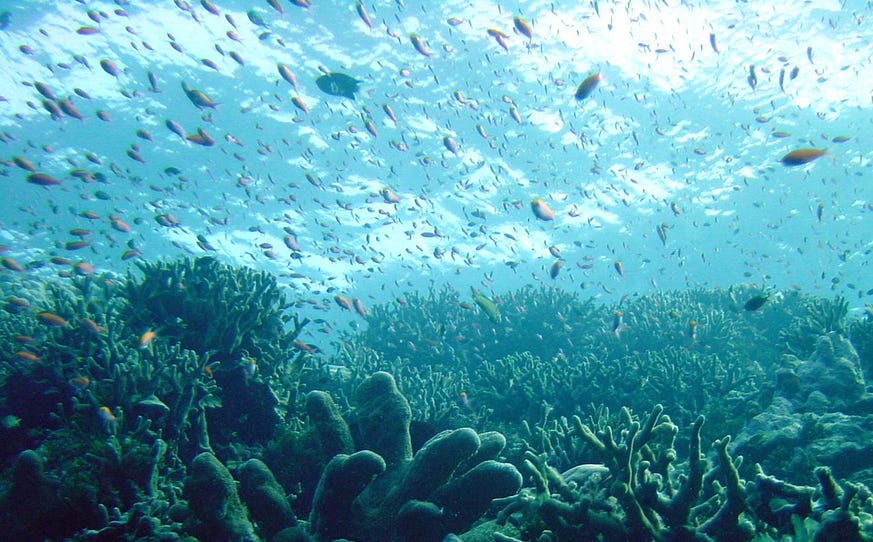Protecting Our Ocean

E.O. Wilson, the eminent scientist and ecologist, has suggested that in order to protect the world’s natural resources against the challenges of climate change and other destructive phenomena — and to conserve these resources and to allow the biosphere to recover and to sustain the needs of our future population growth — we should set aside some 50% of earth in such reserves to meet that essential goal.
In the context of the ocean, this initiative has taken the form of Marine Protected Areas, called MPAs, in an international effort to identify and preserve from harmful practice some of the most fertile ocean places around the world. It is an effort that is continuing and provides a source of optimism and inspiration for ocean conservationists worldwide.
There are some 5000 MPAs already designated, comprising approximately 2.65 million square kilometers, representing 0.8% of the world’s 360 million square kilometers of ocean and 2% of the 147 million square kilometers of ocean under national jurisdiction. These areas are protected as marine parks, national monuments, and environmental reserves under the various legislative regimes of the national or state governments engaged. The largest areas are located in the Republic of Kiribati, Australia, the United States, the Northern Marianas Island, the Galapagos in Ecuador, and Columbia. Most MPAs, however, are small ranging from 5 to 500 square kilometers, located mainly along the coasts, leaving a vast area of oceanic and deep-water habitats unprotected.
Joshua Reichert, Executive Vice President of the Pew Charitable Trust, who has overseen its environmental projects for more than 30 years, addresses the best way to restore and maintain ocean health as follows:
“First, we need to curb overfishing. We must prevent the destruction of essential habitat needed by the ocean life by banning the most destructive fishing gear and practices, and by halting the decline of wetlands and other areas of critical importance to marine life. Also essential is to protect the world’s oceans that are still relatively pristine. One of the most effective ways to accomplish this is by establishing marine reserves where no fishing and other extractive activities are allowed.”
Not every one agrees, and there remains both opposition within governments and by marine fishing and mining interests that see such designations as infringement on commercial activity. There are also questions of definition, regulation, stewardship resources, and enforcement by smaller states with limited budgets and the most to lose. The Pew Trust has in fact joined with partners to initiate satellite surveillance of some of these protected areas to track vessels fishing illegally therein, and some governments have gone so far as to make arrests, to assess fines and penalties, and in some cases to destroy the offending vessels.
What is to be celebrated about the marine protected area movement is its focus first on the most productive places where marine species, plants and animals, can find safety, resilience, and renewal. These places are incubators and sustainers of ocean biodiversity; they contain knowledge and potential for our future that we might not know today or yet understand. They begin to encompass a logical collection of ecosystems, not just in the tropics but also in the far northern and southern waters, in Antarctica and the Artic, and along the coastal edge where salt and fresh water systems meet as part of the global cycle of sustaining water.
Many individuals and environmental organizations are working hard and long on this effort. Among the many achievements that give us optimism and courage about the future of our natural world and our place within it, surely the collaboration and continuing designation of marine protected areas demonstrates a most collective and engaged success. Less than 1% of the ocean has been conserved to date, a far cry from E.O. Wilson’s 50%. But the benefit of every incremental step accrues to each one of us, advances the awareness and logic of our need to conserve ocean resources for family and community, and argues for national and international commitment to such behavior for the protection of us all.
“Protecting Our Ocean” is part of the Earth Optimism Series, 24 posts that will profile conservation actions and innovations to reduce our impacts on the planet. The Earth Optimism Series is brought to you by the World Ocean Observatory in partnership with the Smithsonian Institution’s Ocean Portal, to raise awareness of the Earth Optimism Summit during Earth Day weekend, April 21st through 23rd, 2017 in Washington DC and around the world. Read more solutions and success stories here and share your own ideas at earthoptimism.si.edu.
- Login to post comments
-


